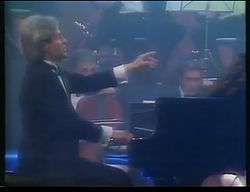Juan Carlos Calderón
| Juan Carlos Calderon | |
|---|---|
|
Luis Miguel and Juan Carlos Calderon (right) | |
| Background information | |
| Born |
7 July 1938 Santander, Spain |
| Died |
25 November 2012 (aged 74) Madrid, Spain |
| Genres | Pop, jazz, bolero |
| Occupation(s) | Songwriter |
| Instruments | piano |
| Years active | 1970s-2010s |
| Associated acts | see below |
| Notable instruments | |
| Piano | |

Juan Carlos Calderón López de Arróyabe (7 July 1938 - 25 November 2012)[1] was a Spanish singer-songwriter and musician.[2]
Born in Santander, he was the author of "Eres tú", which, performed by Mocedades, came second in the Eurovision Song Contest 1973.[3] It was an important hit in several countries. He wrote another three Eurovision entries: "Tú volverás" by Sergio y Estíbaliz in 1975, "La fiesta terminó" by Paloma San Basilio in 1985, and "Nacida para amar" by Nina in 1989; as well as an entry for the OTI Festival: "Amor de medianoche", which ended up runner-up in 1975 performed by Cecilia. He also wrote music for several movies, including the horror films Vengeance of the Zombies (1973) and Blue Eyes of the Broken Doll (1974). In 1968 won an Ondas Award. He wrote songs for artists like Luis Miguel (who won a Grammy with a Calderón song, O Tú o Ninguna),[4] Julio Iglesias, Joan Manuel Serrat, Donald Byrd, Stéphane Grappelli, Bill Coleman, Pedro Iturralde,[5] Herb Alpert, Chayanne, Nino Bravo, Camilo Sesto, Paloma San Basilio, Rocío Durcal, David Bustamante, Mari Trini, Jose Jose, Mijares, Alejandra Ávalos and María Conchita Alonso among others
References
- ↑ "Juan Carlos Calderon". andtheconductoris.eu. Retrieved 29 November 2012.
- ↑ "Juan Carlos Calderón passes away". Esctoday.com. Retrieved 26 November 2012.
- ↑ "Eurovision Song Contest 1973". European Broadcasting Union. Retrieved 19 October 2012.
- ↑ Complete List of First-Ever Latin Grammy Nominations. Billboard. 112. 29 July 2000. p. 46. Retrieved 9 August 2015.
- ↑ "Las cinco canciones de Juan Carlos Calderon que deberias conocer". rollingstone.es. 26 November 2012. Retrieved 9 August 2015.